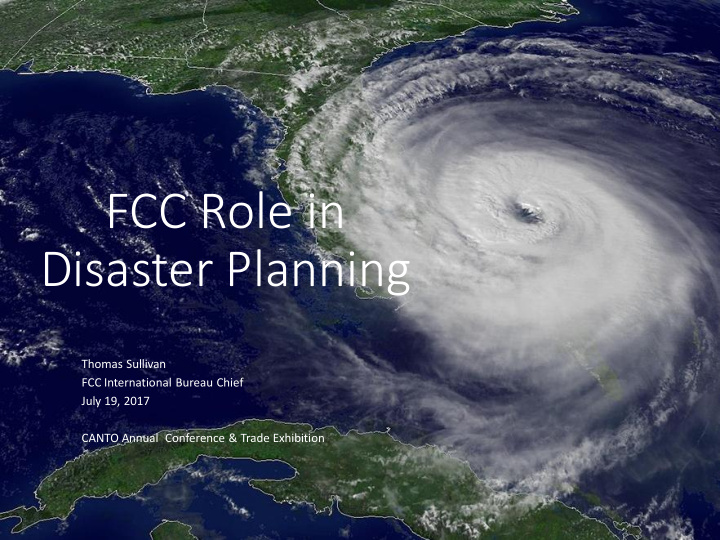



FCC Role in Disaster Planning Thomas Sullivan FCC International Bureau Chief July 19, 2017 CANTO Annual Conference & Trade Exhibition
FCC Regulatory Authority Over Public Safety Communications To promote safety of life and property through the use of communications services, by: • Identification and allocation of public safety spectrum • Licensing of all state, local, and tribal public safety radio systems • Technical rules to promote reliable, interoperable public safety radio communications • Regulation of interference to public safety operations, including from commercial systems • Supporting emergency preparedness and response activities • Serving as a resource and information clearinghouse on issues of public safety and homeland security 2
U.S. Federal Response Structures • All incidents start as local incidents • Three levels for Federal response • National (NRCC) • Regional (RRCC) • Local (Joint Field Office) • FEMA organizes and activates Emergency Support Functions (ESFs) • “Mission Assignments” task and reimburse agencies to do work and deploy personnel • ESF#2: Communications • DHS and FEMA lead • We are a “supporting” agency • Government and Industry coordination • ESF#2 coordinates with other ESFs: energy, transportation, etc. • National Incident Management System (NIMS)
FCC Incident Management: Pre-Game • Response planning • Incident Management Handbook • Continuity of Operations • Continuity of Government • Public Alerting • EAS • WEA • Public Safety Licensing • 911/E911/NG911 • Resiliency initiatives
FCC Incident Management: HQ • Disaster Information Response System (DIRS) / Network Outage Reporting System (NORS) • Special Temporary Authorities • Waivers • Coordination & Info Sharing • DHS: FEMA, National Coordinating Center for Telecommunications • PSAPs and State 9-1-1 administrators • National Telecommunications and Information Administration • Broadcast Associations • Accessibility
FCC Incident Management: Field • ESF#2 staffing • Damage Assessment • Frequency Coordination • On-site RF: Project Roll Call • Scan and analyze: Land mobile radio, TV, AM/FM Roll Call – Hurricane Matthew • Remote RF: • High Frequency Direction Finding • National Shared Remote Equipment Network • Cellular Situational Awareness (developing) HF Remote – Hurricane Katrina
Industry Coordination and Carrier Actions • Preparedness • Emergency Operations Centers • Pre-stage fuel, parts and personnel • Drills and exercises • Deployable assets • Cell on Wheels (COW) • Cell on Light Truck (COLT) • Restoration assets • Wireless Resiliency Framework • Roaming • Mutual Aid • Increasing municipal preparedness • Aid to PSAPs, state EOCs • Increasing consumer preparedness • Public awareness of service and restoration (e.g. public DIRS info) • Typical industry requests: • Power, access, security
FCC Advocacy for Regional and International Cooperation Disaster preparedness and public safety is an IB priority: • Promote best practices and capacity building through regional and international organizations (CITEL, ITU) • Promote regional cooperation and coordination through CITEL, including identifying points of contact for emergency communications issues in NRAs. • Provide ad hoc bilateral support to regulatory counterparts in case of a disaster (Haiti) • Frequent engagement with regulators and policymakers through USTTI and IVP program
Recommend
More recommend